干货整理:ACCA F2科目41条笔记分享
F2ACCA离职周转率知识点解析

F2 .Labor turnover在 F2 的考纲当中,对大家有这样的一个要求“calculate the level, and analyze the costs and causes of labor turnover”。
这篇文章就是对于 labor turnover rate(离职周转率)的计算就考试当中有可能会出到的考题类型为大家做一个说明和总结。
Labor turnover rate 这是一个非常小的知识点,正如大家所见它的计算公式也非常简单,但是它却成了很多同学比较容易错的一个知识点,归其原因,还是大家对于公式的理解不是特别透彻。
下面我们就先从它的定义出发来分析一下什么叫做 labor turnover.“Labor turnover is a measure of the proportion of people leaving relative to the average number of people employed”. 离职周转率是指离职且需要替换回来的员工数量和公司平均员工总人数的比。
用公式表示也就是首先,我们来看一下分母。
分母的含义是公司平均员工总人数。
一年之中人员变动会非常频繁,对每一个时刻都进行人员总数的统计耗时耗资源,所以人力部门一般会在期初和期末对总人数进行统计。
题目中经常出现的考题形式就是告知期初总人数和期末总人数,我们所需要的分母,就是对这两个总人数进行算术平均数的计算。
用公式表示就等于(期初总人数+期末总人数)/2。
例如题目中会给出这样的条件”A company employed3641 employees at the beginning of 20x1 and at the end of the year employees number were 3735”,那么公司平均员工数就等于(3641+3735)/2。
可以说分母干扰的可能性比较小,同学们在分母的计算上面犯错的可能性也很小,主要会出现问题的地方是对于分子计算的把握。
F2ACCA分步成本法知识点解析
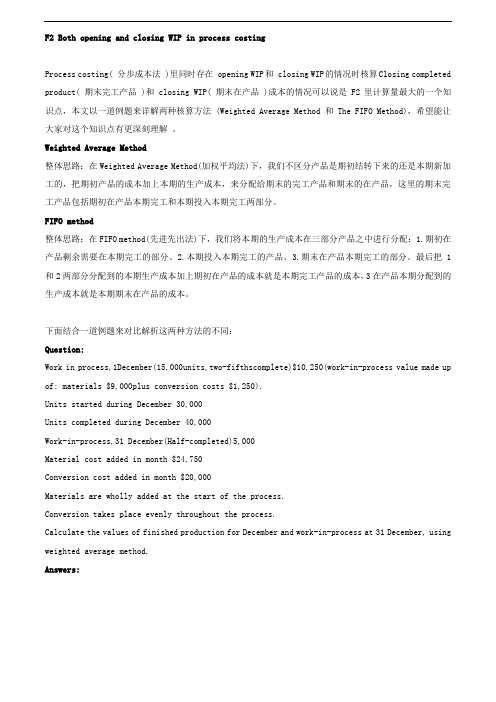
F2 Both opening and closing WIP in process costingProcess costing( 分步成本法 )里同时存在 opening WIP和 closing WIP的情况时核算Closing completed product( 期末完工产品 )和 closing WIP( 期末在产品 )成本的情况可以说是 F2里计算量最大的一个知识点,本文以一道例题来详解两种核算方法 (Weighted Average Method 和 The FIFO Method),希望能让大家对这个知识点有更深刻理解。
Weighted Average Method整体思路:在Weighted Average Method(加权平均法)下,我们不区分产品是期初结转下来的还是本期新加工的,把期初产品的成本加上本期的生产成本,来分配给期末的完工产品和期末的在产品,这里的期末完工产品包括期初在产品本期完工和本期投入本期完工两部分。
FIFO method整体思路:在FIFO method(先进先出法)下,我们将本期的生产成本在三部分产品之中进行分配:1.期初在产品剩余需要在本期完工的部分、2.本期投入本期完工的产品、3.期末在产品本期完工的部分。
最后把1和2两部分分配到的本期生产成本加上期初在产品的成本就是本期完工产品的成本,3在产品本期分配到的生产成本就是本期期末在产品的成本。
下面结合一道例题来对比解析这两种方法的不同:Question:Work in process,1December(15,000units,two-fifthscomplete)$10,250(work-in-process value made up of: materials $9,000plus conversion costs $1,250).Units started during December 30,000Units completed during December 40,000Work-in-process,31 December(Half-completed)5,000Material cost added in month $24,750Conversion cost added in month $20,000Materials are wholly added at the start of the process.Conversion takes place evenly throughout the process.Calculate the values of finished production for December and work-in-process at 31 December, using weighted average method.Answers:Step3: Prepare a statement of costs per equivalent unit(Cost/EU)X。
ACCA F2

Course Notes 2016 Exams September 15 – June 17 ACCAPaper F2 - 双语讲义Management Accounting管理会计Tutor details2 Intro ductio n ACCA F 2No part of this publication may be reproduced, stored in a retrieval systemor transmitted, in any form or by any means, electronic, mechanical,photocopying, recording or otherwise, without the prior written permissionof First Intuition Publishing Ltd.Any unauthorised reproduction or distribution in any form is strictlyprohibited as breach of copyright and may be punishable by law.© First Intuition Publishing Ltd, 2015ACCA F 2Intro ductio n 3ContentsPageIntroduction 1Contents 31Course structure 52Course materials 53Qualification structure 64The exam 65Question types 76Exam tips 77How to study F2 88Study planner 91: Nature, source and purpose of management information 131Accounting for management 132Sources of data 153Cost classification 174Presenting information 262: Cost accounting techniques 331Accounting for material, labour and overheads 332Absorption and marginal costing 533Cost accounting methods 574Alternative cost accounting 703: Budgeting 751Nature and purpose of budgeting 752Statistical techniques 773Budget preparation 904Flexible budgets 975Capital budgeting and discounted cash flows 986Budgetary control and reporting 1107Behavioural aspects of budgeting 1134: Standard costing 1171Standard costing systems 1172Variance calculations and analysis 1183Reconciliation of budgeted and actual profit 1265: Performance measurement 1291Performance measurement overview 1292Performance measurement – application 1313Cost reductions and value enhancement 1414Monitoring performance and reporting 1424 Intro ductio n ACCA F 2Solutions to lecture examples 145Chapter 1 145 Chapter 2 146 Chapter 3 156 Chapter 4 164 Chapter 5 167Formulae sheets 169ACCA F 2Intro ductio n 5 1Course structureHome Study Introduction – How to Study F2To get off to the best possible start, we recommend you contact your tutor once you have receivedyour study materials. Your tutor will explain how to tackle your studies and get you started on yourfirst Study Session.If you prefer to get started straight away you should read “How to Study F2” below.Study sessionsThis study guide breaks down the syllabus into manageable study sessions, following the syllabus, andnumbered in accordance with the chapters in the Study notes. We tell you which chapters to read, andthen which questions to attempt from the Question Bank.It is not enough just to read the study notes. You must practise questions from the Question Bank asrecommended in each study session. The questions in the Question Bank are the same style as thosein the real exam and will give you exposure to all the possible pitfalls.It is better to attempt them as you go along, when the subject matter is fresh in your mind. You shouldcheck your answers with the answers and make sure you understand the suggested answer for anyquestions you get wrong.Revision sessionsWhen you have completed all the study sessions you should spend some time revising the core topicsWhen you are getting most of these right you are ready to attempt the Mock exam. If at all possibleyou should attempt this under real exam conditions, i.e. to the correct time and with no distractions.You can always come and sit your exam at First Intuition – just call your tutor to arrange a convenienttime.When you have completed the Mock you should check your answers. Make a note of any you getwrong and look at the model solution where given. If you still have any problems call your tutor orcome and see us for some final advice. If you score at least 60% in the Mock then you should be readyto take the real exam.2Course materialsYou will receive the following:First Intuition study notesFirst Intuition Question BankPasscards*Online Study Text (in conjunction with Kaplan EN-Gage)*produced by BPP Learning Media6 Intro ductio n ACCA F 23Qualification structureThe ACCA qualification is structured as follows.Fundamentals Level Knowledge Module F1 AB The Accountant in Business F2 MA Management Accounting F3 FA Financial AccountingFundamentals Level Skills Module F4 CL Corporate LawF5 PM Performance ManagementF6 TX TaxationF7 FR Financial ReportingF8 AA Audit & AssuranceF9 FM Financial Management Professional Level Essentials Module P1 PA Professional AccountantP2 CR Corporate ReportingP3 BA Business AnalysisProfessional Level Options Module (any two of these papers) P4 AFM Advanced Financial ManagementP5 APM Advanced Performance Management P6 ATX Advanced TaxationP7 AAA Advanced Audit & AssuranceAll papers are compulsory unless you gain exemptions from a relevant qualification. The modules must be attempted in the correct order, though you can sit the papers in any order. A maximum of fourpapers can be taken in any one exam sitting. Exams are in June and December each year. TheKnowledge Module subjects are examined by computer-based assessment and can be attempted atany time.4The examF2 is a two-hour computer-based or paper based examination.The paper is in two sectionsSection A contains 35 objective test questions. Each question is worth 2 marks (70 marks intotal)Section B contains 3 multi-task questions. Each question is worth 10 marks (30 marks in t otal).Multi task questions are a new question type which is being introduced in 2014. This newquestion type is explained more fully below.All questions are compulsory.The paper has a pass mark of 50%.ACCA F 2Intro ductio n 75 Question typesThe F2 exam consists of the following types of question: Objective test (OT) –These are single, short, automatically marked questions.Multiple task questions (MTQ) – These questions contain a series of tasks which relate t o one or more scenarios.The types of question that may be included are as follows:OT MTQMultiple Choice You are required to choose one answer from a list of options by clicking on the appropriate radio buttonMultiple Response You are required to select more than one response from the options provided by clicking the appropriate tick boxes Multiple Response Matching You are required to select a response to a number of related statements by clicking on the radio button whichcorresponds to the appropriate response for each statement Number Entry You are required to key in a numerical response to the questionGapfill You are required to enter answers into blank areas Hot SpotYou are required to choose one or more answers by clicking on the appropriate hotspot area/ areas on an imageEach of the above types of question are included in the companion Question Bank. Examples of each of the question types and how they are marked can also be found on the ACCA’s website at Specimen examThe ACCA’s specimen exam reflecting the new exam formats and incorporating all question types, is included in this Question Bank.6 Exam tipsRead the requirement very carefully . With calculation questions there are many opportunities for your examiner to confuse you or try and catch you out. It will be very easy to arrive at a result that is one of the options available.Manage your time . You have an average of 2 minutes and 24 seconds per question. S ome will take longer than others, particularly those that involve calculating a numerical answer. So if you get stuck on a question, make a note of the question number and move on. If you have time at the end of the exam you can go back and tackle the tricky questionsYou may be asked to choose one or more correct statements from a given list. Read each statement carefully. If you are unsure about one or more of them, move on and deal with the statements you do agree with. You may find the correct answer by process of elimination without needing to revisit the statements you are unsure about. In any event you should certainly be able to narrow down your choices.If you think you will run out of time, stop five minutes before the end and guess any remaining answers – remember you have a one in four chance of getting those questions right which could make the difference between a pass and a fail.8 Intro ductio n ACCA F 2 7How to study F2Plan your study timeGet your diary out and decide when, where and how often you want to study. If you followed a FirstIntuition course you would receive a minimum of five full days tuition, and be expected to doadditional work at home. Studying on your own is harder and will take longer. You should expect tospend at least 3 hours studying per week. On this basis it should take approximately two months tolearn the study material, then you should allow additional time for revision and final question practice.Most students should be ready to take the exam 3 months after commencing their studies.Set a target date for the examThis is very important with computer-based exams. If you don’t set a target there is a danger that you will spread your study time over too long a period, will lose momentum or simply not get around totaking the exam. When you set your target bear in mind how you wish to progress through thesyllabus, as from paper F4 onwards you are tied to the paper-based exam sittings in June andDecember. For example, if you wish to progress to the Skills level papers for a December sitting youshould complete your computer-based exams by 31 July.Make the most out of your study sessionsTry and complete each study session in one go so that you learn each topic in turn. Some sessions are longer than others, but make sure you take a break between sessions.Read the ACCA study guide at the start of each session so you know the learning outcomes for thatparticular session. Check the tutor tips for advice on how to tackle questions or which areas focus on.Then read the relevant chapter of the course notes.It is essential that you try the questions from the Question Bank where indicated. You will not passthe exam if you don’t attempt the questions. Check your answers and make sure you understand the workings for any that you get wrong. Often you will find that you got the wrong answer because youdidn’t read the question properly – the examiner does like to try and catch you out! If you get stuckgive your tutor a call and ask for advice.RevisionYou should attempt the additional question banks for each of the revision sessions as well as re-reading the study notes. When you are getting at least half of the questions right you are ready toattempt the Mock Exam. If you achieve at least 60% in the Mocks then you should be ready to attempt the real exam.The real examWhen are ready to attempt the real exam give us a call to arrange your CBE (or contact your nearestCBE centre). We hold weekly exam sessions but will do our best to be flexible so you can sit the examat a time that suits you.ACCA F 2Intro ductio n 9 8Study planner10 Intro ductio n ACCA F 2ACCA F 2Intro ductio n 118.1 Practical Experience Requirements (PER) and Performance ObjectivesACCA requires students to have 36 months’ practical experience in order to become members. Part ofthe practical experience requirements is achieving performance objectives that demonstrate that youcan apply what you’ve learnt when studying to real-life, work activities.ACCA has set out 20 performance objectives in 9 areas. You are required to achieve 13 performanceobjectives – all 9 Essentials performance objectives and any 4 Options performance objectives. ACCAhas provided guidance on which objectives are strongly linked to which exam. The relevant objectivesfor F2, which comprise Essentials and Options objectives, are:Manage self (relevant for all exams)(5)Communicate effectively (relevant for all exams)(6)Use information and communications technology (relevant for all exams)(12)Prepare financial information for management (relevant for F2, F5 and P5)(13)Contribute to budget planning and production (relevant for F2, F5 and P5)(14)Monitor and control budgets (relevant for F2, F5 and P5)No part of this publication may be reproduced, stored in a retrieval system or transmitted, in any form or by any means, electronic, mechanical, photocopying, recording or otherwise, without the prior written permission of First Intuition Publishing Ltd.Any unauthorised reproduction or distribution in any form is strictly prohibited as breach of copyright and may be punishable by law.© First Intuition Publishing1 Accounting for management(a)Describe the purpose and role of cost and management accounting within an organisation.(b)Compare and contrast financial accounting with cost and management a ccounting.The purpose of cost and management accounting is to assist the management in running theirbusiness to achieve its overall plans, make the correct decisions and to control the business.1 管理会计(a)描述组织内部成本会计和管理会计的目的与作用。
2014年ACCA考试F2管理会计考前最新知识点
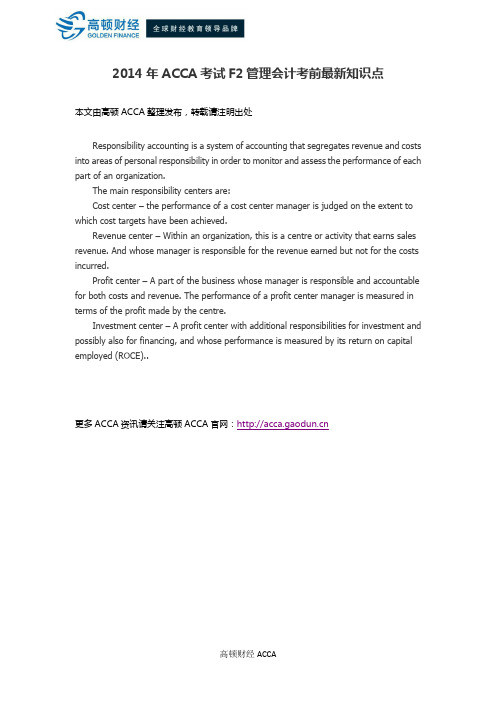
高顿财经ACCA 2014年ACCA 考试F2管理会计考前最新知识点本文由高顿ACCA 整理发布,转载请注明出处 Responsibility accounting is a system of accounting that segregates revenue and costs into areas of personal responsibility in order to monitor and assess the performance of each part of an organization.The main responsibility centers are:Cost center – the performance of a cost center manager is judged on the extent to which cost targets have been achieved.Revenue center – Within an organization, this is a centre or activity that earns sales revenue. And whose manager is responsible for the revenue earned but not for the costs incurred.Profit center – A part of the business whose manager is responsible and accountable for both costs and revenue. The performance of a profit center manager is measured in terms of the profit made by the centre.Investment center – A profit center with additional responsibilities for investment and possibly also for financing, and whose performance is measured by its return on capital employed (ROCE)..更多ACCA 资讯请关注高顿ACCA 官网:。
ACCA F 知识要点汇总 上

Part 1. Audit 介绍*如图所示,审计是受股东委派,直接向股东报告。
External audits 关注财报For auditor to express their opinion and provide assurance to shareholders that the financial statements are prepared, in all material respects , in accordance with an applicable financial reporting framework. 即审计过程的最终目的.关键词:True and Fair, all Material respects, comply with IFRS● Materiality 重要性定义:Information is material if its omission or misstatement could influence theeconomic decisions of users taken on the basis of the financial statements.(相当于,低于多少金额,属于没有重大误报,报告是可接受的。
) Amount (quantity)一般5% ‐ 10% of profit before tax,属于重大Nature (quality)举例:未决诉讼,涉数金额较大;高管调查● Reasonable assurance 合理保证:任何100%保证的描述都是错误的,审计师给不了。
The highest level ofassurance given, as in the case of statutory audit , is described as 'reasonable assurance'. 非绝对的保证is not absolute assurance because there are 固有局限性inherent limitations of an audit which result in the auditor forming an opinion on evidence that is 有说服力的而不是结论性的persuasive rather than conclusive .原因:审计师不可能做到完全客观not objective 。
ACCA基础阶段F1F2F3学习方法介绍
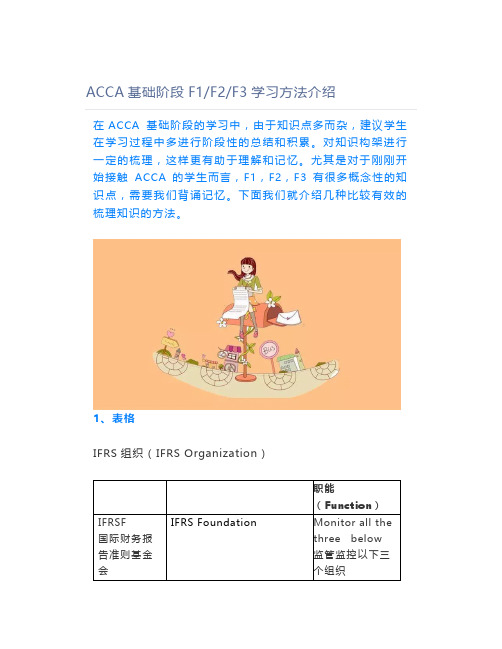
ACCA基础阶段F1/F2/F3学习方法介绍
在ACCA 基础阶段的学习中,由于知识点多而杂,建议学生在学习过程中多进行阶段性的总结和积累。
对知识构架进行一定的梳理,这样更有助于理解和记忆。
尤其是对于刚刚开始接触ACCA的学生而言,F1,F2,F3有很多概念性的知识点,需要我们背诵记忆。
下面我们就介绍几种比较有效的梳理知识的方法。
1、表格
IFRS组织(IFRS Organization)
职能
(Function)IFRSF
国际财务报
告准则基金
会
IFRS Foundation Monitor all the
three below
监管监控以下三
个组织
IASB
国际会计准则理事会International Accounting Standards Board
Issue the
standards
发布准则
IFRS AC 顾问委员会IFRS Advisory Council Advise to IASB
为IASB提供建
议。
IFRS IC
解释委员会IFRS Interpretations
Committee
Interpret
on IFRS and
give guidance
解释IFRS并指导
企业(Entities)2. SmartArt。
ACCA考试全科经验分享 备考经验+日常笔记,出坑小姐姐经验分享

ACCA考试全科经验分享备考经验+日常笔记,出坑小姐姐经验分享今天请到的是一位英语专业的ACCAer还差P7一科就顺利出坑了小姐姐很认真14科每科都有划重点!这份学习方法干货中的干货肯定对备考6月的你有所帮助丨文:黄梦媛南昌师范学院15级商务英语高中学的理科,高考填志愿时,前五个学校选的都是会计专业,最后一个志愿也就是现在我所在的学校,选的是商务英语专业,因为这个学校会计是专科。
再给大家分享一个2019ACCA考试资料包,还可以分享给小伙伴>>>自提,戳:ACCA资料【新手指南】+内部讲义+解析音频进学生会,进社团才慢慢发现,宁愿一人也不想被同化。
每天都是英语相关的课程,我并不喜欢这种生活,于是开始走文学方向,练字、看书投稿让生活变得充实,但因为电台以及文章的敏感导致我整天更加的郁郁寡欢。
有一次听卢思浩的一个采访电台,才发现,原来人可以同时活成两个自己,白天是那个给自己目标,不断突破的人,夜晚可以是那个忘记世界上俗人的压力,倾倒着自己内心的人。
经历很长一段时间迷茫后,我下定了决心要考一个证书,最后看到了ACCA。
去了许多培训机构做对比,高顿的服务态度和专业度让我决定就是它了。
从16年6月底报名,至今还差一门P7出坑,中间有惨痛的Fail过,下面分科和大家分享备考经验。
刚接触ACCA先学的F1,先赞美一下小予老师,央财毕业,很温柔的一个老师,可能是因为她会很真诚地给我们分享一些她的经历及经验,你能感觉到面前的这个人像一个热心的小姐姐,一份难得的真诚。
因为喜欢F1老师,F1学的很开心。
喜欢周末充实的感觉,喜欢和一群目标明确有想法的人一起学习,一起讨论哪家外卖好吃,一起边吃外卖边聊天,大家坐在沙发上看综艺。
【建议】:(1)建议F1-4学完复习1周就直接去考,太久了容易忘记;(2)最好还是按照顺序考,我是先考的F3,再考的F2,最后是F1,F1内容多且杂很容易忘记,所以可以把网课里、课本上的、BPP练习册的知识点用截屏或拍照等方式,按章节顺序放在平板的相册里了,考前直接看这些图片。
ACCAF2学习方法:来自学霸的全套学习计划
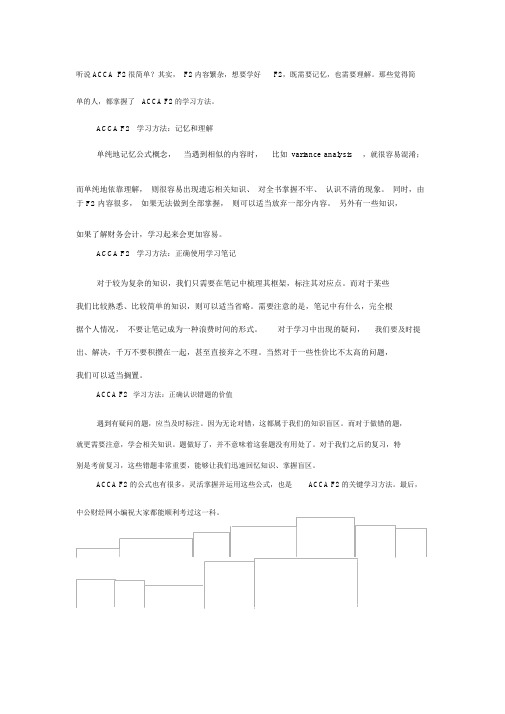
听说 ACCA F2 很简单?其实, F2 内容繁杂,想要学好F2,既需要记忆,也需要理解。
那些觉得简
单的人,都掌握了ACCA F2 的学习方法。
ACCA F2学习方法:记忆和理解
单纯地记忆公式概念,当遇到相似的内容时,比如variance analysis,就很容易混淆;
而单纯地依靠理解,则很容易出现遗忘相关知识、对全书掌握不牢、认识不清的现象。
同时,由于 F2 内容很多,如果无法做到全部掌握,则可以适当放弃一部分内容。
另外有一些知识,
如果了解财务会计,学习起来会更加容易。
ACCA F2学习方法:正确使用学习笔记
对于较为复杂的知识,我们只需要在笔记中梳理其框架,标注其对应点。
而对于某些
我们比较熟悉、比较简单的知识,则可以适当省略。
需要注意的是,笔记中有什么,完全根
据个人情况,不要让笔记成为一种浪费时间的形式。
对于学习中出现的疑问,我们要及时提出、解决,千万不要积攒在一起,甚至直接弃之不理。
当然对于一些性价比不太高的问题,
我们可以适当搁置。
ACCA F2学习方法:正确认识错题的价值
遇到有疑问的题,应当及时标注。
因为无论对错,这都属于我们的知识盲区。
而对于做错的题,
就更需要注意,学会相关知识。
题做好了,并不意味着这套题没有用处了。
对于我们之后的复习,特
别是考前复习,这些错题非常重要,能够让我们迅速回忆知识、掌握盲区。
ACCA F2 的公式也有很多,灵活掌握并运用这些公式,也是ACCA F2 的关键学习方法。
最后,中公财经网小编祝大家都能顺利考过这一科。
ACCA F2 EOQ考试干货分享

ቤተ መጻሕፍቲ ባይዱ
这些公式在考试中是不给的,需要同学们理解记忆滴。 另外在使用 EOQ 公式时,大家要注意: 1. 成本相关,只包括这些受订单数量影响的成本; 2. 公式中所有量的单位要统一,如 CH 题目中是每存储一个产品 oneweek 的成 本是多少,而 Demand 是 one annual 的产品需求量,这两个单位,一个是 week,一个是 annual,要统一,一般以 annual 做单位则要在题目的 CH 基础上 * 52 weeks。 2.批量折扣 BULKDISCOUNTS
文章解析 订购量增加,平均存货量上升,年度总的储存成本增加 订购量增加,订货的次数减少,年度总的订购成本减少
这个模型基于的假设是:买价是固定的;需求和间隔时间是固定的;储存成本受 平均存货量影响;订单成本不受订购量影响;不考虑缺货成本。 所以年储存成本和订购成本的总和先减少,后上升,如上图所示。总的成本最低 点对应的订购数量就是 EOQ,且恰好总成本那条抛物线的最低点和 total holding cost 与 total ordering cost 两条线的交点是重合的,因此可以令 totalholding cost = total ordering cost, 即 Q/2×CH= D/Q×CO, 从而将 EOQ 算出来。
泽稷网校-财务金融证书在线教育领导品牌
大宗购买折扣是否值得采用呢?当价格降低时,如果一次订货量更多,则年储存 成本会上升,所以是否采用这种折扣需要计算分析。即分别算出 EOQ 和刚好能获 得折扣的订货水平下的年总成本(储存、再订购和购买成本),选出最低的那 个,从而判断是否选择折扣优惠。 常用方法为试错法来计算和判断。 Step1:先正常计算出 EOQ Step2:计算出在 EOQ 情况下的 Totalcosts(包括 purchasecost、totalholding cost、totalordering cost) Step3:计算出刚好能获得 discount 的 quantity 的情况下的 Total costs(包括 purchasecost、totalholding cost、totalordering cost) Step4:选择 total costs 最小时的订货数量
ACCA考试科目知识点归纳总结
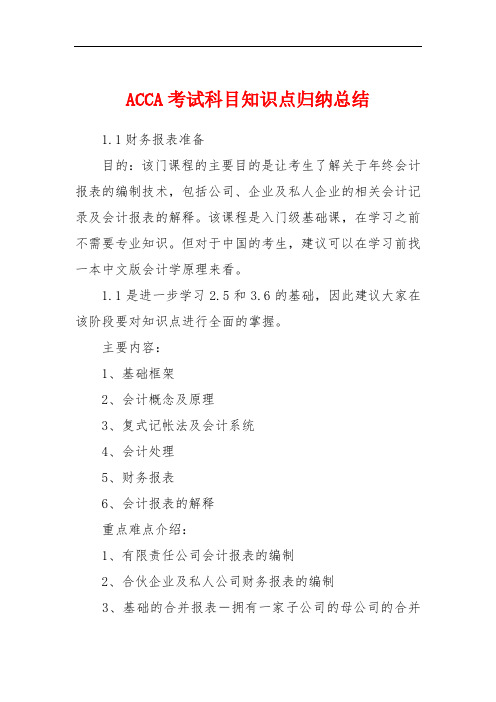
ACCA考试科目知识点归纳总结
1.1财务报表准备
目的:该门课程的主要目的是让考生了解关于年终会计报表的编制技术,包括公司、企业及私人企业的相关会计记录及会计报表的解释。
该课程是入门级基础课,在学习之前不需要专业知识。
但对于中国的考生,建议可以在学习前找一本中文版会计学原理来看。
1.1是进一步学习
2.5和
3.6的基础,因此建议大家在该阶段要对知识点进行全面的掌握。
主要内容:
1、基础框架
2、会计概念及原理
3、复式记帐法及会计系统
4、会计处理
5、财务报表
6、会计报表的解释
重点难点介绍:
1、有限责任公司会计报表的编制
2、合伙企业及私人公司财务报表的编制
3、基础的合并报表-拥有一家子公司的母公司的合并
资产负债表
4、基础的会计记帐及会计程序
5、会计概念及惯例
6、会计报表的解释
7、现金流量表8、会计准则-国际会计准则第1、2、7、
8、10、16、18、35、37、38号
学习技巧:
1、了解考试规则:该门考试的时间为3小时,共分为两个部分。
这两个部分的考察内容来自于大纲的各个部分,并都包含计算和论述两种题型。
在ACCA考试中,50分为及格。
A部分25道单选(2分/题)50分
B部分5道必做题(10分/题)50分
2、科学合理的安排学习时间,制定学习计划,并认真执行计划
3、按时参加辅导课程,从讲师处获得最新咨询
4、保持和同学的交流并相互鼓励
5、练习是ACCA学习中非常关键的步骤,请花尽量多的时间在习题上。
考前必读! ACCA F2的学习方法与做题思路(一)
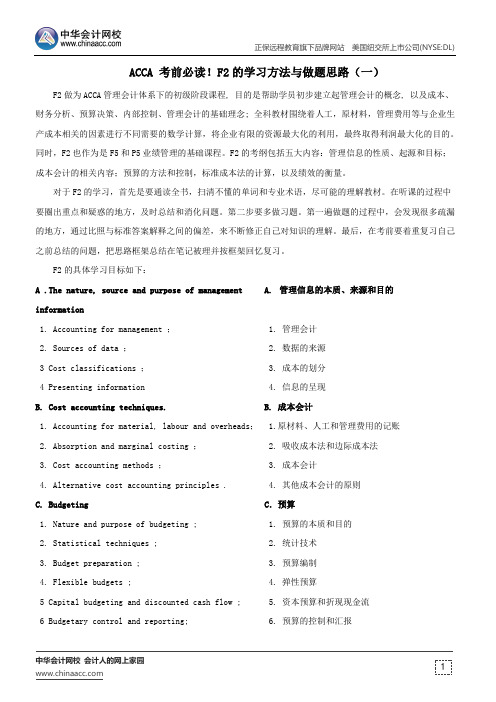
正保远程教育旗下品牌网站美国纽交所上市公司(NYSE:DL)中华会计网校会计人的网上家园ACCA 考前必读!F2的学习方法与做题思路(一)F2做为ACCA管理会计体系下的初级阶段课程, 目的是帮助学员初步建立起管理会计的概念, 以及成本、财务分析、预算决策、内部控制、管理会计的基础理念; 全科教材围绕着人工,原材料,管理费用等与企业生产成本相关的因素进行不同需要的数学计算,将企业有限的资源最大化的利用,最终取得利润最大化的目的。
同时,F2也作为是F5和P5业绩管理的基础课程。
F2的考纲包括五大内容:管理信息的性质、起源和目标;成本会计的相关内容;预算的方法和控制,标准成本法的计算,以及绩效的衡量。
对于F2的学习,首先是要通读全书,扫清不懂的单词和专业术语,尽可能的理解教材。
在听课的过程中要圈出重点和疑惑的地方,及时总结和消化问题。
第二步要多做习题。
第一遍做题的过程中,会发现很多疏漏的地方,通过比照与标准答案解释之间的偏差,来不断修正自己对知识的理解。
最后,在考前要着重复习自己之前总结的问题,把思路框架总结在笔记被理并按框架回忆复习。
F2的具体学习目标如下:A .The nature, source and purpose of managementinformationA.管理信息的本质、来源和目的1. Accounting for management ; 1. 管理会计2. Sources of data ; 2. 数据的来源3 Cost classifications ; 3. 成本的划分4 Presenting information 4. 信息的呈现B. Cost accounting techniques. B. 成本会计1. Accounting for material, labour and overheads; 1.原材料、人工和管理费用的记账2. Absorption and marginal costing ; 2. 吸收成本法和边际成本法3. Cost accounting methods ; 3. 成本会计4. Alternative cost accounting principles . 4. 其他成本会计的原则C. Budgeting C.预算1. Nature and purpose of budgeting ; 1. 预算的本质和目的2. Statistical techniques ; 2. 统计技术3. Budget preparation ; 3. 预算编制4. Flexible budgets ; 4. 弹性预算5 Capital budgeting and discounted cash flow ; 5. 资本预算和折现现金流6 Budgetary control and reporting; 6. 预算的控制和汇报。
ACCA F2知识点:Money Laundering
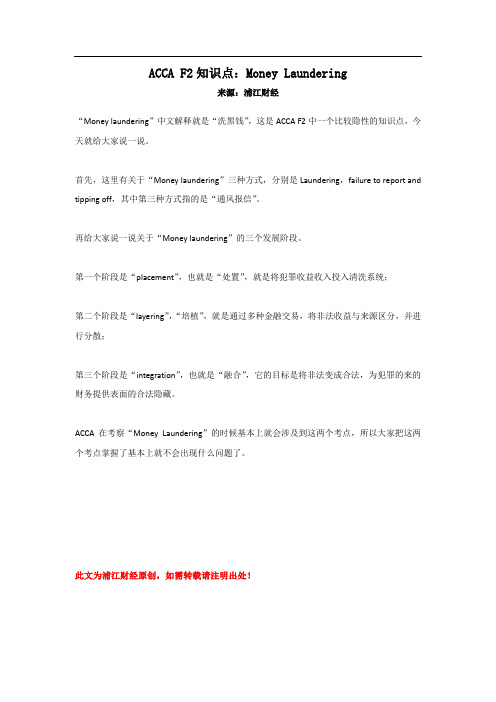
ACCA F2知识点:Money Laundering
来源:浦江财经
“Money laundering”中文解释就是“洗黑钱”,这是ACCA F2中一个比较隐性的知识点,今天就给大家说一说。
首先,这里有关于“Money laundering”三种方式,分别是Laundering,failure to report and tipping off,其中第三种方式指的是“通风报信”。
再给大家说一说关于“Money laundering”的三个发展阶段。
第一个阶段是“placement”,也就是“处置”,就是将犯罪收益收入投入清洗系统;
第二个阶段是“layering”,“培植”,就是通过多种金融交易,将非法收益与来源区分,并进行分散;
第三个阶段是“integration”,也就是“融合”,它的目标是将非法变成合法,为犯罪的来的财务提供表面的合法隐藏。
ACCA在考察“Money Laundering”的时候基本上就会涉及到这两个考点,所以大家把这两个考点掌握了基本上就不会出现什么问题了。
此文为浦江财经原创,如需转载请注明出处!。
NO.38 ACCA最强笔记——ACCA F2 MA Management Accounting (MA)
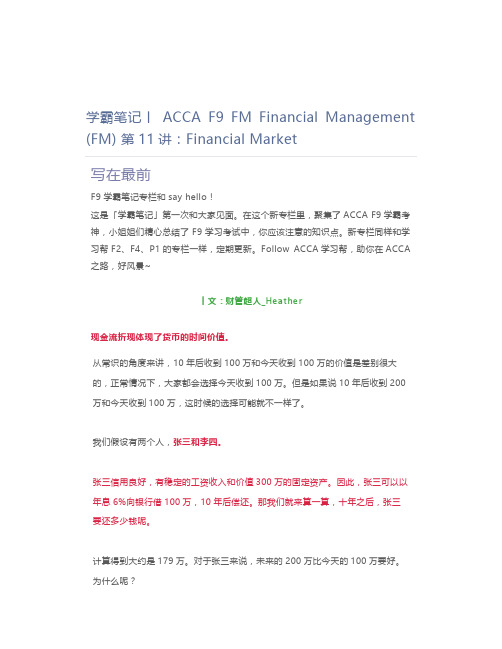
学霸笔记丨ACCA F9 FM Financial Management (FM) 第11讲:Financial Market写在最前F9学霸笔记专栏和say hello!这是「学霸笔记」第一次和大家见面。
在这个新专栏里,聚集了ACCA F9学霸考神,小姐姐们精心总结了F9学习考试中,你应该注意的知识点。
新专栏同样和学习帮F2、F4、P1的专栏一样,定期更新。
Follow ACCA学习帮,助你在ACCA 之路,好风景~丨文:财管超人_Heather现金流折现体现了货币的时间价值。
从常识的角度来讲,10年后收到100万和今天收到100万的价值是差别很大的,正常情况下,大家都会选择今天收到100万。
但是如果说10年后收到200万和今天收到100万,这时候的选择可能就不一样了。
我们假设有两个人,张三和李四。
张三信用良好,有稳定的工资收入和价值300万的固定资产。
因此,张三可以以年息6%向银行借100万,10年后偿还。
那我们就来算一算,十年之后,张三要还多少钱呢。
计算得到大约是179万。
对于张三来说,未来的200万比今天的100万要好。
为什么呢?因为张三可以通过向银行借款,在今天就得到100万,而在10年后,张三得到了200万,偿还了179的贷款,还有21万。
也就是说,对于张三来说,选择10年后的200万,相当于是今天得到100万,10年后还能得到21万。
再来说李四,李四的现金流比较差,且只有一套价值100万的老房子可以作为抵押。
大家知道,向银行贷款,抵押品都是要打折的,因此李四的抵押品是不足够借100万的,这时候银行的贷款利息就会比较高。
假设李四可以以8%的年息向银行贷100万,10年后偿还,那么10年之后,李四需要还大约216万。
因此,对于李四来说,选择10年后的200万,相当于今天得到100万,10年后还要给银行16万。
所以对于李四来说,他会选择今天的100万。
总结就是,对于张三来说,他宁愿用今天的100万的代价来换10年后的200万,因为对他来说,10年后的200万价值大于今天的100万。
ACCA F阶段知识整理
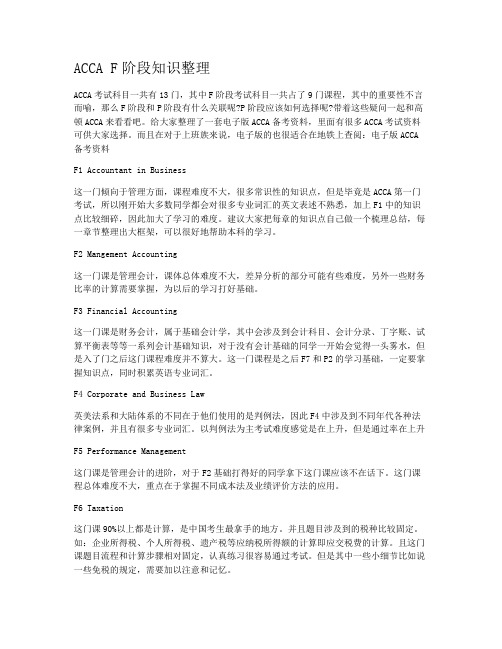
ACCA F阶段知识整理ACCA考试科目一共有13门,其中F阶段考试科目一共占了9门课程,其中的重要性不言而喻,那么F阶段和P阶段有什么关联呢?P阶段应该如何选择呢?带着这些疑问一起和高顿ACCA来看看吧。
给大家整理了一套电子版ACCA备考资料,里面有很多ACCA考试资料可供大家选择。
而且在对于上班族来说,电子版的也很适合在地铁上查阅:电子版ACCA 备考资料F1 Accountant in Business这一门倾向于管理方面,课程难度不大,很多常识性的知识点,但是毕竟是ACCA第一门考试,所以刚开始大多数同学都会对很多专业词汇的英文表述不熟悉,加上F1中的知识点比较细碎,因此加大了学习的难度。
建议大家把每章的知识点自己做一个梳理总结,每一章节整理出大框架,可以很好地帮助本科的学习。
F2 Mangement Accounting这一门课是管理会计,课体总体难度不大,差异分析的部分可能有些难度,另外一些财务比率的计算需要掌握,为以后的学习打好基础。
F3 Financial Accounting这一门课是财务会计,属于基础会计学,其中会涉及到会计科目、会计分录、丁字账、试算平衡表等等一系列会计基础知识,对于没有会计基础的同学一开始会觉得一头雾水,但是入了门之后这门课程难度并不算大。
这一门课程是之后F7和P2的学习基础,一定要掌握知识点,同时积累英语专业词汇。
F4 Corporate and Business Law英美法系和大陆体系的不同在于他们使用的是判例法,因此F4中涉及到不同年代各种法律案例,并且有很多专业词汇。
以判例法为主考试难度感觉是在上升,但是通过率在上升F5 Performance Management这门课是管理会计的进阶,对于F2基础打得好的同学拿下这门课应该不在话下。
这门课程总体难度不大,重点在于掌握不同成本法及业绩评价方法的应用。
F6 Taxation这门课90%以上都是计算,是中国考生最拿手的地方。
(完整版)ACCAF2知识要点汇总情况(精简版),推荐文档
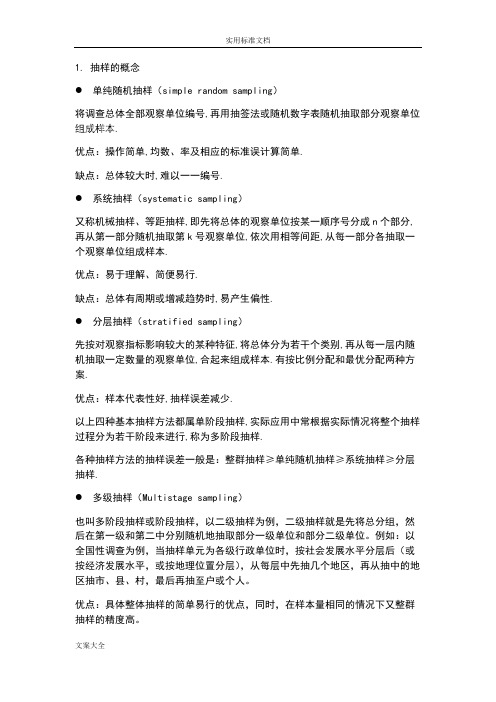
优点:易于理解、简便易行.
缺点:总体有周期或增减趋势时,易产生偏性. 分层抽样(stratified sampling)
先按对观察指标影响较大的某种特征,将总体分为若干个类别,再从每一层内随 机抽取一定数量的观察单位,合起来组成样本.有按比例分配和最优分配两种方 案.
文案大全
实用标准文档
建议收藏下载本文,以便随时学习!
8. ABC – 要知道它和AB的区别。
9. Life Cycle Costing: Introducgh promotion cost + Basic
文案大全
实用标准文档
quality Growth: New competitors + New distribution outlets being found +
缺点:容易掩盖不可忽略的偏差。
2. 成本的划分:
文案大全
实用标准文档
建议收藏下载本文,以便随时学习!
3. Inventory 公式: Re‐order level = maximum demand x maximum lead time Min. stock level = re‐order level –(average demand x average
优点:样本代表性好,抽样误差减少.
以上四种基本抽样方法都属单阶段抽样,实际应用中常根据实际情况将整个抽样 过程分为若干阶段来进行,称为多阶段抽样.
各种抽样方法的抽样误差一般是:整群抽样≥单纯随机抽样≥系统抽样≥分层 抽样. 多级抽样(Multistage sampling)
ACCAF 知识点总结

Chapter11. 民法(civil law)和刑法(criminal law )的划分Civil law: an form of private law , used by individuals to assert rights against other individualsCriminal law: an aspect of public law to regulate1.primary legislation(made by theParliament)/secondary legislation( in exercise of law-making powers delegated by Parliament). [注:Necessity for delegatedlegislation/secondary legislation :moreconvenient ;can hand over the task of specifying the law in detail to experts] 2. 在case law 中:common law 普通法[created byjudges through the application of the principle of judicial precedent. common law drew oncustoms/equity law 衡平法:to resolve disputes where damages are not a suitable remedy and to introduce fairness into the legal system.] 2. 不同法院管辖事件的类型decided on the basis of the law established inearlier cases.2.可以创立判例法规则: Supreme Court/Court ofAppeal/High Court;不可以创立:Crown,Magistrates, County Courts cannot createprecedent.3.Elements of judicial decision(影响法庭判决的因素):ration decidendi判决理由[the reason for thedecision]/Obiter dicta附带说明[statement madeby the way, not binding, but merely of persuasive authority]4.法官又可以因为那些理由拒绝先例(disregardingjudicial precedent): Overrule取代[the procedurewhereby a court higher in the legal hierarchy sets aside a legal ruling established in a previouscase]/Reverse推翻[a procedure whereby a court higher in the hierarchy reverses the decision of a lower court in the same case]/Distinguishing法官的自由裁决[a precedent is avoided by a judgedemonstrating that the material facts of two cases are not the same] 5.Rules of Statutory Interpretation(法的解释):①theliteral approach :the literal rule[means that words in the Act should be given their literal andgrammatical meaning rather than what the judge thinks they mean./the golden rule :this rule isapplied in circumstances where the application of the literal rule is likely to result in an obviouslyabsurd result. ②the purposive approach :thejudge should ,where necessary ,look beyond thewords of statute to find out the reason/purposefor its enactment, and that meaning should beinterpreted in the light of the purpose[Mischiefrule :purposive approach的具体表现形式/wherea statute is designed to remedy a weakness inthe law, the correct interpretation is the one which achieves it.]6.语言处理规则(法律没有追溯力a statute doesnot have retrospective effect)Chapter3 合同法(IMP)1.合同的概念a legally binding agreement enforceablein law2.从要约到承诺是否达成agreement [invitations totreat要约邀请--offer要约--acceptance承诺----agreement]3.Termination of an offer:express rejection/counteroff反要约/lapse of time/revocation of anoff/death/if the off is suject to a condition,it willlapse on failure of that condition4.Privity of Contract合同相对性原则: the commonlaw doctrine that only those are party to thecontract---have rights or liabilities under thecontract/ have the right to enforce thecontract,contracts cannot give rights or obligationsto othersChapter41.分类标准Express and lmplied terms:某个条款是否经过双方当事人协商同意(agreed by the parties)Condition,warranties and innominate terms 核心,从属和无名条款:根据条款重要性2.免责条款(三观概念)Any clause that attempts to exempt , or limit, the liability of one party for breach of contract ornegligence3 test: correctly incorporated into the contract形式正确/worded clearly to exclude the breach措辞清晰/reasonable per statute内容合理Chapter5 1.type of breach⏹Repudiatory breach根本性违约:refusal toperform拒绝履行/failure to perform an entireobligation不履行某项/incapacitation无力履行/breach of condition 违反核心条款/breachof an innominate term违反无名条款⏹Anticipatory breach预期违约:未到合同履行时间,当事人提前说明无法履行;收到预期违约通知可立即追究违约责任,也可等到履行合同时间追究责任Lawful excuses for non-performance开脱责任:performance is impossible因不可预见的事情发生不可履行/尝试履行被拒绝/ the other party make it impossible for him to performance/contract is discharged through frustration情势变更/the party have been agreement permitted non-performance 2.Remedies : when a breach occurs, the court hasto decide what the appropriate remedy should be.3.Liquidated damage违约金:a genuinepre-estimate of the loss在订立合同前已经商定了,有利于解纠纷,如果违约金过高(远大于loss)判为惩罚性,则不可执行4.specific performance :the court directs a partyto complete their contractual obligations以下几种情况法官不会让合同继续履行:courtscannot supervise法官无力监督履行/personalservice/minors involvedChapter6 Tort侵权法A wrongful act against an individual which gives riseto a civil claim.1.过失侵权的4个证明环节(概念标准内容)Negligence:It arises when one person suffers damage or injury though the negligent act(or omission to act)of another person.注意义务(三步走原则)合理预见原则关联性原则公平合理地强加注意义务②A breach of that duty违反注意义务1.general rule:The test for establishing breach of duty is an objective one:a breach of duty occurs if the defendant:”...fails to do something which a reasonable man...would do.”2.Special factors to considera.The probability of injuryb.The seriousness of the risk造成伤害的严重性c.Cost and practicability成本可行性mon practice证明是行业误差范围内e.Skilled persons/professionalsf.Social benefit③The breach of duty caused harm to the claimant违反义务是导致损失的原因1.The but for test2.No break in the chain of causation切断因果关系链的要素a.A natural eventb.Act of a third party 原侵权人不承担责任c.Act of the claimant④The loss ware not too remote主张的赔偿合理Reasonable foresight只赔偿违法者可以合理预见的部分2.抗辩事由①Contributory negligence共同过失(一般只是减少赔偿额,个别情况全部免除)②Volenti non fit injuria同意不生违法(彻底免除)Chapter7 劳动法1.身份判别①Control test :The amount of control that one person had over the other②Integration test不会外包给他人的,不可或缺的③Multiple test/Economic reality testa. The regularity and method of payment报酬支付频率,支付方式b. The ownership of tools and equipment是否提供工具c. The regularity of hours of work工作时间d. The ability to delegate all the work/to provide substitute是否代理2.义务①Common Law Duties-Employers’ common law duties1)Duty of mutual trust and confidence2)To provide work for workers3)To pay wages/remuneration4)To indemnify employee against expenses and losses5)To provide for the care and safety of the employee6)No duty to provide reference when employees leave-Employees’ common law duties1) To obey reasonable and lawful orders2) To act faithfully/duty of faithful service/duty to account for all money and property3) To exercise reasonable skill and care in any activity in their role as an employee/reasonable competence to do his job4) Personal service亲自完成交付的责任②Statutory Duties1)Pay and equality不能低于国家平均2) Time off work3)Trade union officials工会组织罢工可以参加,还要给工资4) Every woman has a right to maternity leave and some are entitled to maternity pay5) Health and safety6)Working time:17week,not exceed 48 hours for each 7 days除非员工书面同意多工作7) Flexible workingChapter81.解雇通知时间的计算1m-2Y: not less than 1 week2y-12y:1 week for each year≥12y: not less than 12 week劳动者离职要提前一周通知,合同期满不续则每工作一年折合一个月工资2.自动正当参加非法集合罢工unofficial industrial action/对国家安全有威胁自动不正当怀孕pregnancy/员工参加工会活动/收购并购时的解雇dismissal on transfer of an undertaking/工作存在安全问题/最低工作标准/作息时间/员工在周天拒绝工作3.用人单位解雇不当Chapter9 代理法1.代理关系建立方式Express agreement between the agent andprincipal达成委托代理协议合同,口头书面皆可Implied agreement默认没有代理协议但默认存在关系Ratification追任代理人先履行合同,事后委托人建立合同关系Without consent of principal 没有征得委托人同意就建立关系necessity/Estoppel2.代理权限(3)Express authority明示代理权限Implied authority默认代理权限Apparent/ostensible authority看起来有代理权限,实际上并没有Chapter10 合伙企业法1.合伙企业(概念):the relationships that subsistsbetween persons carrying on a business incommon with a view to profit. standardpartnership is not s separate legal entity and itspartners have full personal liability for the debts of partnership.2.Termination/dissolution合伙企业解散的债务处理:paying off external debts/repaying to thepartners any loans or advances/repaying thepartner’s capital contribution/anything left over isthen repaid to the partners in the profit sharingratio .3.Termination/dissolution合伙企业解散的条件:expiry of a fixed period stipulated in thepartnership agreement/completion of the express purpose for which the partnership wasformed/partner gives notice to leave/a newpartner is admitted into the partnership/death orbankruptcy of partner/happening of any eventwhich makes company can’t carry on/onapplication by a partner the Court may decree adissolution of the partnership4.Sole trade宏观特征:is not a separate legal entity,the person and business are viewed as the same legal entity5.Authority合伙人的代理权限:express authority明示代理权限[from partnership agreement]/impliedauthority默示代理权限/apparent authority表面代理权限[已经退伙但其他人不知道]6. A partner’s liability usually extends to the periodfor which were actually a partner of a firm. 合伙人只对担任合伙人期间合伙企业产生的债务有清偿责任7.Limited Partnership(LP)特征:the partnership mustbe register with the Company Registry/one ormore of the partners must bear full,unlimitedliability/partners with limited liability may not take part in management and cannot usually bind thebusiness in contract/limited partner cannotwithdraw their capital8.Limited Liability Partnership(LLP)特征:must beregistered with the the Registrar of Companies,with formation documents signed by at least twomembers/has a legal personality separate/ thename of partnership must end with LLP/partnersare known as members, of which there must beat least two/LLPs must file annual returns andaccounts/all members are agents of LLP/allmembers’ liability is limited/a designated member is responsible for administration and filing/LLP is not subject to corporation taxChapter121.设立pre-incorporation contacts谁来履行?Promoters发起人2.交什么文件①Memorandum of association公司章程(89年)②Application for registration注册申请书③A statement of capital and initial shareholdings关于公司资本坏人原始持有股份的状况说明④Statement of compliance遵从声明⑤A statement of company’s proposed officers拟任命谁为公司管理人员⑥A copy of any proposed articles of association自拟公司章程(06年)不是必须提交,没交使用默认模版3.2个证书的功能①Certificate of incorporation注册许可证Private company 只需要注册许可证,是形式审查②Trading certificate营业许可证Public company需要两个证,申领到注册许可证后一年内要申领到营业许可证,否则强制清算,是实质审查a.Allotted share capital is at least £50,000(允许股东分批缴纳)b.At least one quarter of the nominal value of the allotted share capital has been paid up(minimum £12,500)首次不低于票面的1/4,为确保一开始不会有资金困难c.Details of promoters’ expenses设立费用具体怎么产生d.A statement of compliance in respect of payment of nominal values and share premium4.章程修改的程序和内容-Contentsa. Directors’ powers and responsibilityb. Decisions making by directorsc. Appointment of directorsd. Organization and conduct of general meetingse. Issue and transference of sharesf. Payment of dividendsg. Exercise of members’ rights-Alteringa. Passing a special resolution通过股东会的特别决定,3/4以上同意批准b. Providing the alteration has been made “bona2.普通股优先股的概念和差异1.概念shares may be issued at a price above their nominal value, the difference between the issueprice and the nominal value is a share premium用途the issue of fully paid bonus share/writing off the preliminary expenses of company formation/writing off the discount on the issue of debentures/repurchase of debentures at a premiumChapter11 公司法The consequences of separate legal personality for the company are as follows:(1897年案例引出的规则)1: members' liability is limited.2: perpetualsuccessionbecomepossible asthecompanywill need tobe formallywounded-up.3: the company itself can own property.4 :the company can use, and be sued in its own name.Types of company (公司的分类)。
ACCA答题技巧:关于F2我有很厉害的答题套路
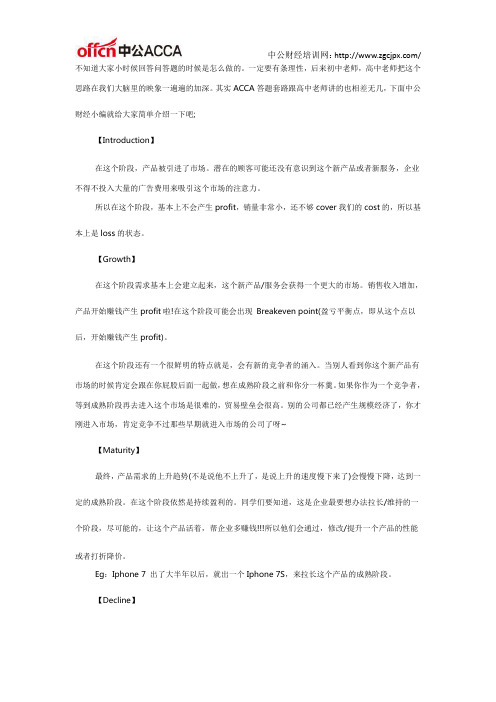
中公财经培训网:/不知道大家小时候回答问答题的时候是怎么做的。
一定要有条理性,后来初中老师,高中老师把这个思路在我们大脑里的映象一遍遍的加深。
其实ACCA答题套路跟高中老师讲的也相差无几,下面中公财经小编就给大家简单介绍一下吧;【Introduction】在这个阶段,产品被引进了市场。
潜在的顾客可能还没有意识到这个新产品或者新服务,企业不得不投入大量的广告费用来吸引这个市场的注意力。
所以在这个阶段,基本上不会产生profit,销量非常小,还不够cover我们的cost的,所以基本上是loss的状态。
【Growth】在这个阶段需求基本上会建立起来,这个新产品/服务会获得一个更大的市场。
销售收入增加,产品开始赚钱产生profit啦!在这个阶段可能会出现Breakeven point(盈亏平衡点,即从这个点以后,开始赚钱产生profit)。
在这个阶段还有一个很鲜明的特点就是,会有新的竞争者的涌入。
当别人看到你这个新产品有市场的时候肯定会跟在你屁股后面一起做,想在成熟阶段之前和你分一杯羹。
如果你作为一个竞争者,等到成熟阶段再去进入这个市场是很难的,贸易壁垒会很高。
别的公司都已经产生规模经济了,你才刚进入市场,肯定竞争不过那些早期就进入市场的公司了呀~【Maturity】最终,产品需求的上升趋势(不是说他不上升了,是说上升的速度慢下来了)会慢慢下降,达到一定的成熟阶段。
在这个阶段依然是持续盈利的。
同学们要知道,这是企业最要想办法拉长/维持的一个阶段,尽可能的,让这个产品活着,帮企业多赚钱!!!所以他们会通过,修改/提升一个产品的性能或者打折降价。
Eg:Iphone 7 出了大半年以后,就出一个Iphone 7S,来拉长这个产品的成熟阶段。
【Decline】最后我们来到衰退期。
在成熟期,市场买入了足够的该产品,因此最终该产品的市场肯定是会达到饱和的。
这个时候,需求就会开始下降了。
最终,这个产品会变成一个loss-maker,到了那个时候,企业就该考虑停止销售那个产品/服务了。
ACCA考试科目F2重要知识:Planning and Control

ACCA考试科目F2重要知识:Planning and Control 2019年01月07日ACCA考试科目F2把管理活动总结为三个词:planning, control and decision-making. 这里通过举例讲解一下Planningand control.小编再送一个考试资料包,可以分享给小伙伴,自提,戳:ACCA资料【新手指南】+内部讲义+解析音频1.Planning(关键词是objective/goal andstrategy)(i) Establish the company’sgoal: increase profit by 20% in five years.(ii) Identify alternativestrategies to achieve the goal:Increase market sharethrough price promotionDevelop new products withhigher customer value (i.e. better price/quality mix)Cost reductionAcquisition ofcompetitors(iii) Analyze the alternativesand make a choice, e.g. develop new products(iv) State the expectedoutcomes towards the goal in the form of annual budget把总目标分解成五个年度目标,并用预算的形式表达出来(如:每年的销售额是多少,其中新产品带来多少销售,新产品开发费用是多少,利润是多少)注:F2不要求考生设定目标或选择策略,只要求判断哪些活动属于Planning。
2. Control (关键词是Compare) (i) Obtain data about actualresults(ii) Compare the actual withthe plan (e.g. with the profit stated in annual budget)(iii) Take improvement actionsand/or revise the original plan 如果实际和计划有差异,可能是实际执行的问题,也可能是计划本身不合理。
- 1、下载文档前请自行甄别文档内容的完整性,平台不提供额外的编辑、内容补充、找答案等附加服务。
- 2、"仅部分预览"的文档,不可在线预览部分如存在完整性等问题,可反馈申请退款(可完整预览的文档不适用该条件!)。
- 3、如文档侵犯您的权益,请联系客服反馈,我们会尽快为您处理(人工客服工作时间:9:00-18:30)。
干货整理:ACCA F2科目41条笔记分享ACCA F2全称是Management Accounting,这一门课程是管理会计的内容,课程总体难度不大,差异分析的部分考试可能有些难度,另外一些财务比率的计算需要掌握,为今后的学习打好基础。
以下是学员整理的一些F2学习笔记供新学员参考:1.Target cost=target selling price–target profit=market price–desired profit margin.2.cost gap=estimated cost–target cost.3.TQM:①preventing costs②appraisal costs③internal failure costs④external failure cost4.Alternative costing principle:①ABC(activity based costing)②Target costing③Life cycle④TQM8.Time series:①trend②seasonal variation:⑴加法模型sum to zero;⑵乘法模型sum to4③cyclical variation④random variation9.pricipal budget factor关键预算因子:be limited the activities10.budget purpose:①communication②coordination③compel the plan④motivative employees⑤resource allocation11.Budget committee的功能:①coordinated②administration12.Budget:①function budget②master budget:1.P&L;2.B/S;3.Cash Flow13.Fixed Budget:不是在于固不固定,而是基于一个业务量的考虑,financail expression.Flexible Budget:包含了固定成本和变动成本,并且变动成本的变化是随着业务量的变化而改变。
14.Flexible Budget的优点:①recognize different cost behavior.②improve quality and a comparison of like with like③help managers to forecast cost,revenue and profit.15.Flexible Budget的缺点:1假设太简单。
2需要更多的时间准备预算编制。
16.Controllable cost is a“cost which can be influenced by”its budget holder.大部分的变动成本是可控的,non-controllable cost为inflation.17.Budget Behavior:①participate approach②imposed budget18.payback投资回收期的缺点:①ignore profitability②the time value of money is ignored③没有考虑项目后期带来的经济利益④arbitray武断19.payback投资回收期的优点:①easy to calculate②widely use③minimize the effect of the risk and help liqidity★如果在算投资回收期的时候,发生折旧,则需要加回折旧,因为折旧是非现金项目。
20.(1+real interst rate)*(1+inflation rate)=(1+nominal interest rate)21.NPV=present value of future net cash flow–present value of initial cost22.永续年金=A/i23.每年的汇报是相同的就查看年金现值系数表,不同的就查看年金系数表。
24.EAR=CAR=APR=(1+r/n)n–1有效年利率25.IRR:(based on cash flow analysis)①IRR>cost of capital,NPV>0,worth taking②IRR<cost of capital,NPV<0,not worthwhile.26.ARR=average profit/average investment(ARR是基于profit)Average investment=(initial investment–residual value)/227.type of standard:①basic standard②current standard③ideal standard④attainable standard28.Variance1.Material Variance⑴total material variance=standard cost–actual cost⑵material price variance=(standard price–actual price)*actual quantity⑶material usage variance=(standard usage of actual output-actual usage)*standard price. 2.Direct Labor Variance⑴standard pay–actual pay⑵Labor rate variances=(standard rate–actual rate)*actual hrs of actual output⑶Labor efficiency variances=(standard hrs of actual output–actual hrs)*standard rate 3.Variable production overhead variances⑴Total variable O.H.variance=standard cost–actual cost⑵Variable O.H.expenditure variance=(standard rate–actual rate)*actual hrs⑶Variable O.H.efficiency variance=(standard hrs of actual output–actual hrs)*standard rate4.Fixed O.H.expenditure variance⑴Fixed O.H.Expenditure variance=budget expenditure–actual expenditure⑵Fixed O.H.volume=(actual output-budgeted volume)*standard hrs per unit*standard rate per hr.⑶Capacity variance=(actual hrs worked–budgeted hrs worked)*standard rate per hr⑷Efficiency variance=(standard hrs worked for actual output–actual hrs worked)*standard rate per hr⑴+⑵:Fixed O.H.total variance=fixed O.H.absorbed–actual expenditure 5.Sales variance⑴Sales price variances=(actual price–budget price)*actual sales units⑵Sales volume variances=(actual sales units–budget sales units)*standard profit per unit (absorption)⑶Sales volume variances=(actual sales units–budget sales units)*standard CPU(marginal costing)6.Idle time variancesIdle time variance=(expected idle time–actual idle time)*adjusted hr rate29.The elements of a mission statement including:①Purpose②Strategy③Policies and standards of behavior④Values and culture30.A critical success factor is a performance requirement that is fundamental to competitive success.31.Profitability ratios①Return on capital employed(ROCE)=profit before interest and tax/(shareholders’funds+long-term liabilities)×100%②Return on equity(ROE)=profit after tax/shareholders’funds×100%③Asset turnover=sales/capital employed×100%=sales/(shareholders’funds+long-term liabilities)×100%④Profit margin=profit before interest and tax/sales×100%Profit margin×asset turnover=ROCE32.Debt and gearing ratios①Debt-to-equity ratio=long-term liabilities/total equity×100%②Interest cover=PBIT/Interest×100%33.Liquidity ratios①Current ratio=current assets/current liabilities②Quick ratio(acid test ratio)=current assets minus inventory/current liabilities34.Working capital ratios①Inventory days=average inventory*365/cost of sales②Receivables days=average trade receivables*365/sales③Payables days=average trade payables*365/cost of sales(or purchases)35.Non-financial performance measuresNon-financial performance measures are considered to be leading indicators of financial performance.①Market share②Innovation③Growth④Productivity⑤Quality⑥Social aspects36.The balanced scorecard:①financial perspective②external perspective③customer perspective④learning and innovation perspective37.Benchmarking:①Internal benchmarking②Competitive benchmarking③Functional benchmarking④Strategic benchmarking38.Value analysis is a planned,scientific approach to cost reduction,which reviews the material composition of a product and the product's design so that modifications and improvements can be made which do not reduce the value of the product to the customer or user.39.Four aspects of'value'should be considered:①Cost value②Exchange value③Utility value④Esteem value40.ROI=PBIT/capital employed*100%Widely used and accepted;As a relative measure it enables comparisons to be made with divisions or companies of different sizes.41.RI=PBIT-Imputed interest*capital employed.Possible to use different rates of interest for different types of assets;Cost of finance is being considered.。
